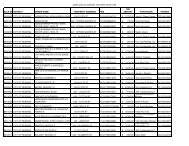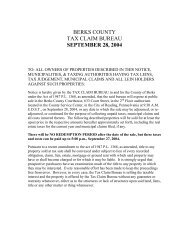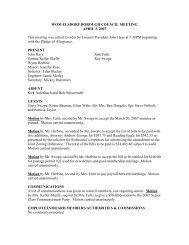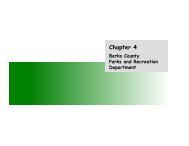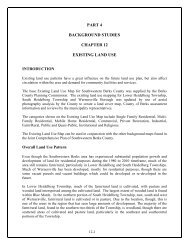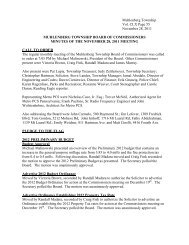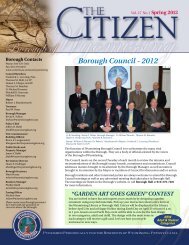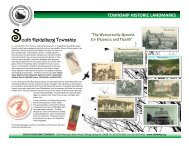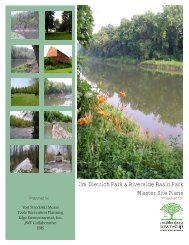Historic and Cultural Resources Plan - Berks County
Historic and Cultural Resources Plan - Berks County
Historic and Cultural Resources Plan - Berks County
Create successful ePaper yourself
Turn your PDF publications into a flip-book with our unique Google optimized e-Paper software.
4. Develop programs, events <strong>and</strong> interpretive signage <strong>and</strong> exhibits that<br />
emphasize the history of the Region<br />
5. Evaluate the potential for historic districts <strong>and</strong> support their creation if<br />
warranted. If created, support the adoption of voluntary or m<strong>and</strong>atory<br />
Design Guidelines <strong>and</strong> Sign Controls for the <strong>Historic</strong> District.<br />
C. Support the activities of individuals <strong>and</strong> groups that identify, document, evaluate,<br />
<strong>and</strong> protect historical resources <strong>and</strong> increase public awareness of the area’s history<br />
<strong>and</strong> historic resources.<br />
HISTORIC PRESERVATION AT THE STATE AND LOCAL LEVEL<br />
Establishing a local <strong>Historic</strong> District requires an assessment of the present status of the<br />
community’s historic resources, knowledge of past historic preservation efforts, <strong>and</strong> a list of<br />
goals <strong>and</strong> objectives. Taking such an assessment enables the designating community to take<br />
advantage of historic preservation incentives available at the national, state, <strong>and</strong> local<br />
governmental levels, such as grants, income tax credits for historic rehabilitation, lowinterest<br />
loans, <strong>and</strong> local tax abatements. A requirement of establishing a local district,<br />
provided it was created pursuant to Act 167, the <strong>Historic</strong> District Act, is the establishment of<br />
a <strong>Historic</strong> Architectural Review Board (HARB). The HARB reviews all proposed erection,<br />
reconstruction, alteration, restoration, or demolition of buildings within the district before<br />
the issuance of any municipal permits pursuant to these actions. HARB reviews <strong>and</strong><br />
recommendations must be consistent with the design guidelines established at the enactment<br />
of the <strong>Historic</strong> District. The Township Supervisors or Borough Council have the right to<br />
incorporate any of the HARB’s recommendations into the permit requirements, but they<br />
may also override those recommendations. Municipalities whose districts are not created<br />
under Act 167 are not required to have a HARB, but instead may appoint a <strong>Historic</strong> District<br />
Commission or Committee.<br />
The Region contains two potential <strong>Historic</strong> Districts, Main Street in Bernville, <strong>and</strong> portions<br />
of the New Schaefferstown Village.<br />
Two Pennsylvania laws provide the legal foundation for municipalities to adopt historic<br />
ordinances <strong>and</strong> regulatory measures.<br />
Act 247 – The Pennsylvania Municipalities <strong>Plan</strong>ning Code (MPC)<br />
Acts 67 <strong>and</strong> 68 of 2001 amended the MPC, strengthening the ability of local governments to<br />
protect historic resources through their Comprehensive <strong>Plan</strong>s, Zoning Ordinances <strong>and</strong><br />
12-11





